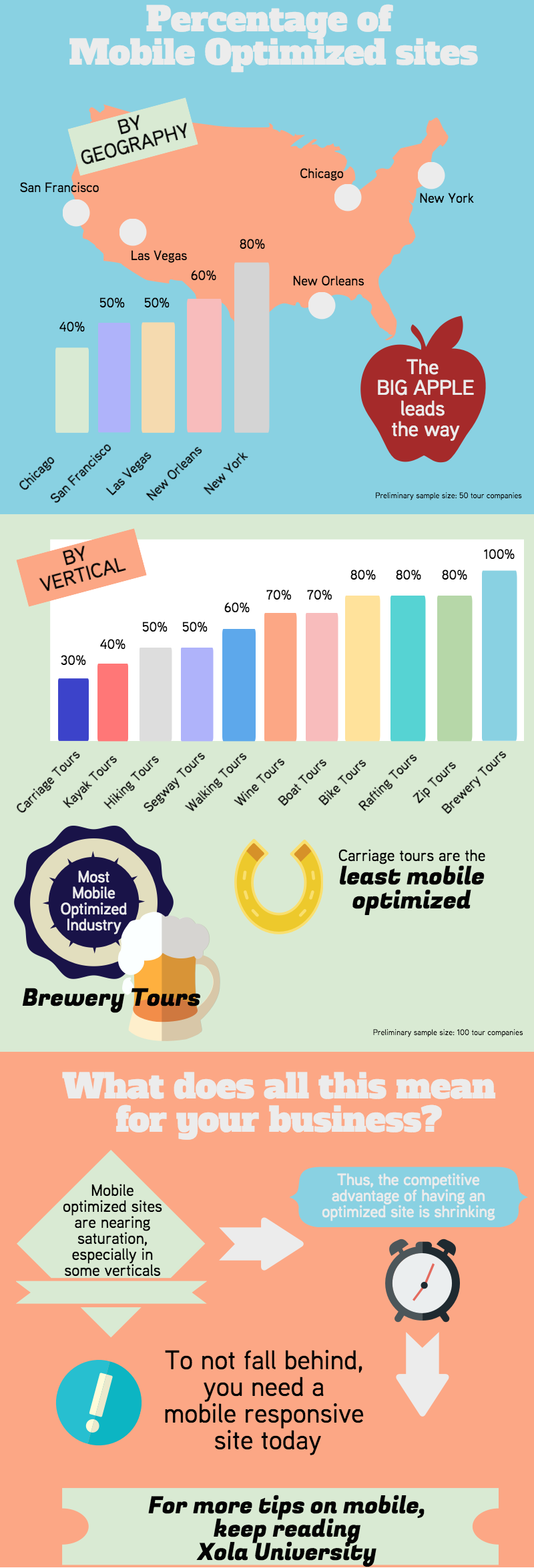
Optimize for Mobile or Bust!
Researching and buying tours on mobile devices is no longer a trend: it’s here to stay. Eighty percent of the top zip tours on TripAdvisor already have mobile optimized sites. Mobile optimization is not an advantage anymore, it’s a necessity.
Why? Because more and more people are researching and purchasing tours from their phones.
Between 2014 and 2015, tour operators found that mobile and tablet visitors jumped from 32% to 55%! According to booking data from Xola, an online booking and marketing system for zip tours, half of all bookings start on a mobile phone or tablet. Forty-eight percent of people complete their booking from a mobile device, and nearly 30% of completed online reservations come from smartphones alone.
This means that on average, mobile purchases generate almost half of the booking volume in the tour and activity industry. If you haven’t optimized your website, therefore, you’ve been kissing a lot of dough goodbye.

Invest in Your First Impression
Given the large amount of people planning travel on their mobile devices, chances are that they’ll first come across your brand and your offerings on their phones.
All those first impressions are chances to cultivate future customers. For Austin Albers, the General Manager at Buffalo Outdoor Center, 57% of people that come to the website arrive via their mobile device.

But whether it’s a new customer or a returning one, “you want to make the experience as awesome as possible,” says Kenneth Lippman of Another Side Tours.
Competition among tour and activity operators is rising. Your first impression–otherwise known as your brand–will be what sets you apart.
If someone sees a busted site when she searches on her phone, that automatically defines part of your brand. The chances that she’ll navigate through your website and book a tour, zooming and scrolling every which way, are not in your favor.
Invest in mobile designs that will impress web visitors from the get-go.
Book Now
A mobile optimized site is not only important for first impressions, but is also crucial in facilitating immediate bookings. After all, where better to pull the trigger than right on your phone?
With two thumbs, a customer can call, email, book a tour, and even read your reviews.
“You spend a lot of money on PPC, SEO, social media, everything, just to get them to go to your website,” Lippman says,” you don’t want someone to bail just because it doesn’t look right.”
Moreover, as in-destination bookings rise over the next several years, capturing eager buyers on mobile will be even more important. Already, 23% of people booking or researching travel do it once they’ve arrived at their destination.
“I want to make sure that people like myself, who are working on the phone constantly, feel comfortable on our website,” Lippman explains.
Your 3 Next Steps Toward a Better Mobile Website
So with all this in mind, here’s how to properly invest in a mobile site that will boost your business:
- Make sure it’s optimized: Do not make your customers pinch their mobile screens to book a tour. Implement designs that make it easy for visitors to navigate from their phones.
- Remember that technology changes: Even if you already have a mobile optimized site, your work is not yet over. At the rate that technology and design are changing, it’s important to update your website every 1½ – 2 years.
- Measure, measure, measure: Data should be at the core of every decision you make. How else will you know if your money is being spent wisely? Don’t do 90% of the work only to never make it to the finish line. By analyzing your website’s mobile usage metrics, you can fully analyze the return on your investment.
Which Tours Are Best on Mobile?
Not all tour companies optimize equally. This infographic breaks down data from top-ranked businesses on TripAdvisor both by geography and vertical. These findings merely scratch the surface, but perhaps they’ll inspire some insights or ideas about your own competitive landscape and the proliferation of mobile sites.




